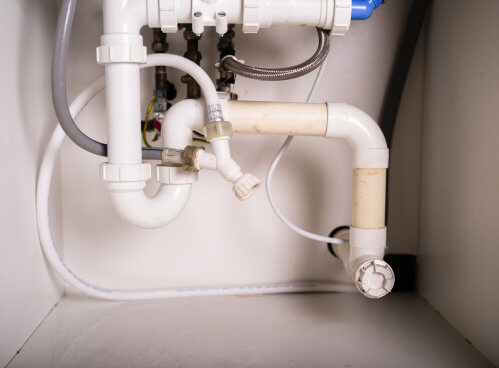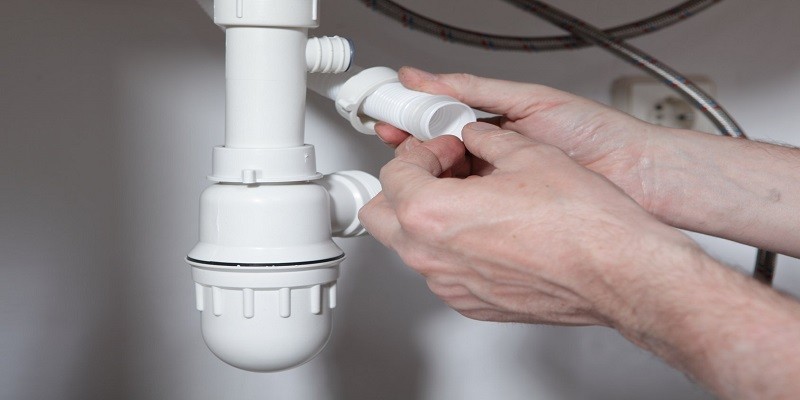Last Updated on October 18, 2023
To clean a sink trap, remove the trap using a wrench and clean out any debris before reattaching. A sink trap is an essential plumbing component that prevents sewer gases from entering your home while allowing water to flow freely down the drain.
Over time, this trap can become clogged with hair, food particles, and other debris, resulting in slow drainage and unpleasant odors. Regularly cleaning the sink trap is crucial for maintaining a healthy and functional sink. We will provide a step-by-step guide on how to clean a sink trap effectively.
By following these instructions, you can keep your sink trap clear, ensuring smooth drainage and preventing any potential plumbing problems.

Credit: baileyokc.com
The Sink Trap
At the heart of your sink’s drainage system lies a small but crucial component called the sink trap. This often overlooked feature plays a significant role in managing waste and preventing clogs in your plumbing system. Understanding the purpose and function of a sink trap is essential for ensuring smooth and efficient drainage.
Function Of A Sink Trap:
- Traps solid debris: The sink trap is designed to trap solid debris that might otherwise flow down the drain, such as food particles, hair, and soap scum. It prevents these substances from entering the plumbing system and causing clogs.
- Retains water: A sink trap contains a small amount of water, which creates a seal. This water seal acts as a barrier, preventing sewer gases from escaping back into your home. It helps maintain a pleasant environment by keeping foul odors at bay.
- Allows easy access for cleaning: Sink traps can be easily accessed and removed, allowing you to clean out any trapped debris efficiently. The cleaning process helps restore proper flow and prevents unpleasant odors.
Importance Of Cleaning The Sink Trap Regularly:
- Prevents clogs: Over time, the sink trap can accumulate debris and become clogged. Regular cleaning helps you remove this buildup and prevent potential blockages in your plumbing system. By keeping the trap clean, you ensure smooth drainage and minimize the risk of costly plumbing repairs.
- Reduces foul odors: A dirty sink trap can produce unpleasant odors that permeate your kitchen or bathroom. Cleaning the trap regularly eliminates these odors, creating a fresh and hygienic environment in your home.
- Improves overall hygiene: The accumulation of debris in the sink trap can become a breeding ground for bacteria and other harmful microorganisms. Cleaning the trap keeps these organisms at bay, promoting a clean and healthier living space.
- Extends the life of your plumbing system: Neglecting to clean the sink trap can lead to clogs that cause strain on your plumbing system. Regular cleaning helps maintain the longevity and efficiency of your pipes, avoiding costly repairs or replacements.
Remember to include cleaning the sink trap in your regular cleaning routine to ensure a well-functioning and hygienic plumbing system. The next section will guide you through the step-by-step process of cleaning your sink trap effectively.
Steps To Clean The Sink Trap
Cleaning a sink trap is an essential maintenance task that ensures your sink drains smoothly and prevents clogs. By following a few simple steps, you can easily clean the sink trap yourself. Gather the necessary tools and supplies, prepare the sink area, remove the sink trap, clean it thoroughly, reinstall it, and test for proper drainage.
Step 1: Gather Necessary Tools And Supplies
Before starting the cleaning process, it’s crucial to gather all the necessary tools and supplies. Here’s what you’ll need:
- Bucket or basin
- Rubber gloves
- Adjustable wrench
- Pipe brush or small bottle brush
- Cleaning solution (such as a mixture of water and vinegar or a mild detergent)
Step 2: Prepare The Sink Area
Preparing the sink area helps avoid any mess or damage while cleaning. Follow these preparatory steps:
- Clear the area around the sink and remove any items that might obstruct your work.
- Place a bucket or basin underneath the sink trap to catch any water or debris that may come out.
Step 3: Remove The Sink Trap
Now, it’s time to remove the sink trap. Follow these steps:
- Locate the sink trap, which is usually below the sink bowl and connected to the drainpipe.
- Put on your rubber gloves for protection.
- Use an adjustable wrench to loosen the slip nuts that secure the sink trap to the drainpipe and tailpiece.
- Gently twist and pull the sink trap off the drainpipe and tailpiece. Be cautious, as there might be some water or debris inside.
Step 4: Clean The Sink Trap Thoroughly
Once you’ve successfully removed the sink trap, it’s time to clean it thoroughly. Here’s how:
- Inspect the sink trap for any visible clogs or debris. Remove them manually using gloves or tweezers.
- Rinse the sink trap with warm water to remove any loose residue.
- Prepare a cleaning solution by mixing water and vinegar or using a mild detergent.
- Dip a pipe brush or small bottle brush into the cleaning solution.
- Scrub the inside and outside surfaces of the sink trap to remove grime, grease, or any remaining debris.
- Rinse the sink trap thoroughly with warm water to ensure it’s clean and free from any cleaning solution residue.
Step 5: Reinstall The Sink Trap
Now that the sink trap is clean, it’s time to reinstall it. Follow these steps:
- Align the sink trap with the drainpipe and tailpiece.
- Insert the slip nuts and tighten them by hand.
- Use the adjustable wrench to securely tighten the slip nuts, but be careful not to overtighten and damage the connections.
Step 6: Test For Proper Drainage
Finally, it’s important to test the sink trap to ensure proper drainage. Here’s what you should do:
- Turn on the water and let it run down the sink.
- Observe the flow of water to ensure it goes smoothly through the drain without any leaks or blockages.
- Check underneath the sink for any signs of water dripping or pooling, indicating a potential issue.
Following these steps will help you clean your sink trap effectively and maintain the optimal performance of your sink’s drainage system. By regularly cleaning the sink trap, you can prevent unpleasant odors, clogs, and potential plumbing problems.
Maintenance Tips For Sink Trap
Regular cleaning schedule:
- Cleaning the sink trap regularly is essential to prevent clogs and unpleasant odors.
- Aim to clean the sink trap at least once every three months or as needed, depending on usage.
- To start, gather the necessary tools, such as a bucket, rubber gloves, and a pipe brush, before you begin the cleaning process.
- Turn off the water supply to the sink before removing the trap to avoid any spills or leaks.
- Slowly unscrew the trap from the drain pipe using a wrench or pliers, being careful not to damage the pipes.
- Empty the contents of the trap into a bucket, disposing of any debris or gunk properly.
- Rinse the trap with warm water and scrub it gently with a pipe brush, ensuring you remove any remaining residue.
- Once cleaned, reattach the trap to the drain pipe, making sure it is securely fastened.
- Finally, turn the water supply back on and check for any leaks before resuming regular use of the sink.
Prevention of clogs and odors:
- The sink trap plays a crucial role in preventing clogs and minimizing odors in your kitchen or bathroom.
- To avoid blockages, it’s essential to be mindful of what goes down the drain.
- Avoid pouring cooking oils, grease, coffee grounds, and food scraps down the sink, as these can accumulate and cause clogs.
- Use a sink strainer or catch basket to catch large debris and prevent it from entering the sink trap.
- To combat unpleasant odors, consider using natural cleaners, such as a mixture of baking soda, vinegar, and boiling water.
- Regularly flushing the drain with hot water can also help prevent odor buildup and keep the sink trap functioning optimally.
Signs of a damaged sink trap:
- Over time, sink traps can become damaged or worn out, leading to issues such as leaks or inefficient drainage.
- Look out for signs of a damaged sink trap, including visible cracks or rust on the trap itself.
- Leaks around the trap area or foul odors that persist despite regular cleaning may also indicate a problem.
- If you notice water pooling around the trap or experiencing slow drainage, it’s worth inspecting the sink trap for any issues.
- Damaged sink traps should be replaced promptly to prevent further damage and ensure proper functioning of your sink.
Troubleshooting common sink trap issues:
- Occasionally, you may encounter common issues with your sink trap that can be resolved with a few troubleshooting techniques.
- If you’re experiencing a clog, try using a plumber’s snake or a drain plunger to gently dislodge the obstruction.
- For stubborn clogs, a mixture of baking soda and vinegar can be poured down the drain to help break up the blockage.
- If your sink trap is leaking, ensure that it is tightly connected to the drain pipe. If the leak persists, consider replacing the washers or gaskets.
- Unpleasant odors can be eliminated by regularly cleaning the sink trap as mentioned earlier or using enzyme-based cleaners specifically designed for eliminating odor-causing bacteria.
Regular maintenance and prompt troubleshooting are key to keeping your sink trap in optimal condition. By following these simple tips, you can ensure efficient drainage, prevent clogs, and maintain a clean and odor-free sink area.
Frequently Asked Questions Of How To Clean A Sink Trap?
How Often Should You Clean A Sink Trap?
It is recommended to clean your sink trap at least once every 3 months to prevent clogs and odors.
What Tools Do You Need To Clean A Sink Trap?
To clean a sink trap, you will need a bucket, pliers, a pipe wrench, a brush, and a drain cleaner.
Can You Clean A Sink Trap Without Removing It?
Yes, you can clean a sink trap without removing it by using a drain cleaner and a brush to remove debris.
Why Does A Sink Trap Smell Bad?
A sink trap can smell bad due to trapped food particles, bacteria, and mold. Regular cleaning can help eliminate the odor.
How Can You Prevent Clogs In A Sink Trap?
To prevent clogs in a sink trap, avoid pouring oil, grease, and coffee grounds down the drain. Use a drain strainer to catch debris.
Conclusion
Cleaning a sink trap is an essential task to maintain the cleanliness and functionality of your sink. By regularly removing debris and buildup from the trap, you can prevent clogs and foul odors from developing in your kitchen or bathroom.
Remember to always turn off the water supply and use gloves before starting the cleaning process. Start by removing the trap and emptying its contents into a bucket. Use a pipe brush or a toothbrush to scrub away any residue or grime.
Rinse the trap thoroughly before reattaching it to the pipes. By following these simple steps, you can keep your sink trap free from blockages and ensure a smooth flow of water. Don’t forget, regular maintenance is key to prolonging the life of your sink and avoiding costly repairs in the future.




